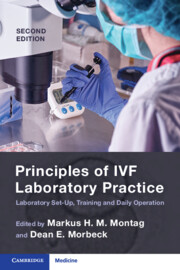Book contents
- Principles of IVF Laboratory Practice
- Principles of IVF Laboratory Practice
- Copyright page
- Contents
- Contributors
- Foreword
- The Evolution of IVF Practice
- Section 1 Starting a New Laboratory and Training Protocols
- Section 2 Pre-procedure Protocols
- Section 3 Gametes
- Section 4 Insemination/ICSI
- Chapter 21 General Insemination for IVF
- Chapter 22 Conventional IVF with Short Co-incubation
- Chapter 23 Technical Aspects of ICSI for Ejaculated Spermatozoa
- Chapter 24 Set-Up and Adapted Protocol for Piezo-ICSI
- Chapter 25 Sperm Selection for ICSI by Morphology
- Chapter 26 Sperm Selection for ICSI by Viability
- Chapter 27 Artificial Oocyte Activation for IVF
- Section 5 Fertilization Assessment
- Section 6 Embryo Assessment: Morphology and Beyond
- Section 7 Embryo Cryopreservation
- Section 8 Embryo Transfer
- Section 9 Quality Management
- Index
- References
Chapter 25 - Sperm Selection for ICSI by Morphology
MSOME/IMSI
from Section 4 - Insemination/ICSI
Published online by Cambridge University Press: 07 August 2023
- Principles of IVF Laboratory Practice
- Principles of IVF Laboratory Practice
- Copyright page
- Contents
- Contributors
- Foreword
- The Evolution of IVF Practice
- Section 1 Starting a New Laboratory and Training Protocols
- Section 2 Pre-procedure Protocols
- Section 3 Gametes
- Section 4 Insemination/ICSI
- Chapter 21 General Insemination for IVF
- Chapter 22 Conventional IVF with Short Co-incubation
- Chapter 23 Technical Aspects of ICSI for Ejaculated Spermatozoa
- Chapter 24 Set-Up and Adapted Protocol for Piezo-ICSI
- Chapter 25 Sperm Selection for ICSI by Morphology
- Chapter 26 Sperm Selection for ICSI by Viability
- Chapter 27 Artificial Oocyte Activation for IVF
- Section 5 Fertilization Assessment
- Section 6 Embryo Assessment: Morphology and Beyond
- Section 7 Embryo Cryopreservation
- Section 8 Embryo Transfer
- Section 9 Quality Management
- Index
- References
Summary
Spectacular progress in the therapeutic management of patients with severe male infertility was obtained with the implementation of intracytoplasmic sperm injection (ICSI) and has opened avenues to treating previously untreatable cases of infertility. However, it must be recognized that in the vast majority of ICSI cycles, the selection of the spermatozoon followed by the intracytoplasmic injection is done very quickly at low magnification and without detection possibilities for potential pathological morphological anomalies of spermatozoa. Strong correlations between sperm morphological characteristics and male fertility have been demonstrated. Thus, it seems reasonable to implement optimized non-invasive sperm selection techniques in ART based on morphological ’normalcy’ of spermatozoa. Almost 20 years ago, ’motile-sperm organelle morphology examination’ (MSOME) was introduced by Bartoov et al. Using Nomarski differential interference contrast optics (DIC) an improved three-dimensional view of the head and midpiece became available. This chapter will describe different aspects of sperm selection by morphology.
- Type
- Chapter
- Information
- Principles of IVF Laboratory PracticeLaboratory Set-Up, Training and Daily Operation, pp. 186 - 195Publisher: Cambridge University PressPrint publication year: 2023



